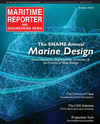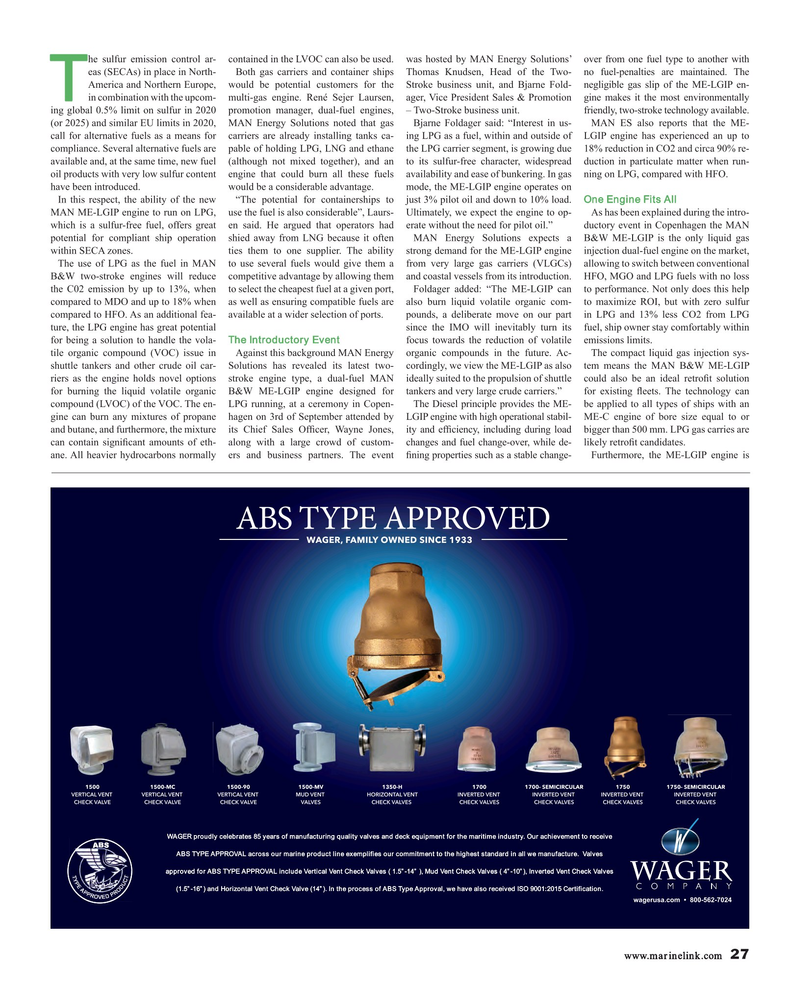
Page 27: of Maritime Reporter Magazine (October 2018)
Marine Design Annual
Read this page in Pdf, Flash or Html5 edition of October 2018 Maritime Reporter Magazine
he sulfur emission control ar- contained in the LVOC can also be used. was hosted by MAN Energy Solutions’ over from one fuel type to another with eas (SECAs) in place in North- Both gas carriers and container ships Thomas Knudsen, Head of the Two- no fuel-penalties are maintained. The
America and Northern Europe, would be potential customers for the Stroke business unit, and Bjarne Fold- negligible gas slip of the ME-LGIP en-
T in combination with the upcom- multi-gas engine. René Sejer Laursen, ager, Vice President Sales & Promotion gine makes it the most environmentally ing global 0.5% limit on sulfur in 2020 promotion manager, dual-fuel engines, – Two-Stroke business unit. friendly, two-stroke technology available.
(or 2025) and similar EU limits in 2020, MAN Energy Solutions noted that gas Bjarne Foldager said: “Interest in us- MAN ES also reports that the ME- call for alternative fuels as a means for carriers are already installing tanks ca- ing LPG as a fuel, within and outside of LGIP engine has experienced an up to compliance. Several alternative fuels are pable of holding LPG, LNG and ethane the LPG carrier segment, is growing due 18% reduction in CO2 and circa 90% re- available and, at the same time, new fuel (although not mixed together), and an to its sulfur-free character, widespread duction in particulate matter when run- oil products with very low sulfur content engine that could burn all these fuels availability and ease of bunkering. In gas ning on LPG, compared with HFO.
have been introduced. would be a considerable advantage. mode, the ME-LGIP engine operates on
In this respect, the ability of the new “The potential for containerships to just 3% pilot oil and down to 10% load. One Engine Fits All
MAN ME-LGIP engine to run on LPG, use the fuel is also considerable”, Laurs- Ultimately, we expect the engine to op- As has been explained during the intro- which is a sulfur-free fuel, offers great en said. He argued that operators had erate without the need for pilot oil.” ductory event in Copenhagen the MAN potential for compliant ship operation shied away from LNG because it often MAN Energy Solutions expects a B&W ME-LGIP is the only liquid gas within SECA zones. ties them to one supplier. The ability strong demand for the ME-LGIP engine injection dual-fuel engine on the market,
The use of LPG as the fuel in MAN to use several fuels would give them a from very large gas carriers (VLGCs) allowing to switch between conventional
B&W two-stroke engines will reduce competitive advantage by allowing them and coastal vessels from its introduction. HFO, MGO and LPG fuels with no loss the C02 emission by up to 13%, when to select the cheapest fuel at a given port, Foldager added: “The ME-LGIP can to performance. Not only does this help compared to MDO and up to 18% when as well as ensuring compatible fuels are also burn liquid volatile organic com- to maximize ROI, but with zero sulfur compared to HFO. As an additional fea- available at a wider selection of ports. pounds, a deliberate move on our part in LPG and 13% less CO2 from LPG ture, the LPG engine has great potential since the IMO will inevitably turn its fuel, ship owner stay comfortably within for being a solution to handle the vola- The Introductory Event focus towards the reduction of volatile emissions limits.
tile organic compound (VOC) issue in Against this background MAN Energy organic compounds in the future. Ac- The compact liquid gas injection sys- shuttle tankers and other crude oil car- Solutions has revealed its latest two- cordingly, we view the ME-LGIP as also tem means the MAN B&W ME-LGIP riers as the engine holds novel options stroke engine type, a dual-fuel MAN ideally suited to the propulsion of shuttle could also be an ideal retro? t solution for burning the liquid volatile organic B&W ME-LGIP engine designed for tankers and very large crude carriers.” for existing ? eets. The technology can compound (LVOC) of the VOC. The en- LPG running, at a ceremony in Copen- The Diesel principle provides the ME- be applied to all types of ships with an gine can burn any mixtures of propane hagen on 3rd of September attended by LGIP engine with high operational stabil- ME-C engine of bore size equal to or and butane, and furthermore, the mixture its Chief Sales Of? cer, Wayne Jones, ity and ef? ciency, including during load bigger than 500 mm. LPG gas carries are can contain signi? cant amounts of eth- along with a large crowd of custom- changes and fuel change-over, while de- likely retro? t candidates.
ane. All heavier hydrocarbons normally ers and business partners. The event ? ning properties such as a stable change- Furthermore, the ME-LGIP engine is
ABS TYPE APPROVED
WAGER, FAMILY OWNED SINCE 1933 1500-90 1500-MC 1500 1500-MV 1350-H 1700 1700- SEMICIRCULAR 1750 1750- SEMICIRCULAR
VERTICAL VENT VERTICAL VENT VERTICAL VENT MUD VENT HORIZONTAL VENT INVERTED VENT INVERTED VENT INVERTED VENT INVERTED VENT
CHECK VALVE CHECK VALVE CHECK VALVE VALVES CHECK VALVES CHECK VALVES CHECK VALVES CHECK VALVES CHECK VALVES
WAGER proudly celebrates 85 years of manufacturing quality valves and deck equipment for the maritime industry. Our achievement to receive
ABS TYPE APPROVAL across our marine product line exemplifies our commitment to the highest standard in all we manufacture. Valves approved for ABS TYPE APPROVAL include Vertical Vent Check Valves ( 1.5”-14” ), Mud Vent Check Valves ( 4”-10”), Inverted Vent Check Valves
T T T T
T T
Y Y
C C
P P
U U
D D
A A E E (1.5”-16”) and Horizontal Vent Check Valve (14”). In the process of ABS Type Approval, we have also received ISO 9001:2015 Certification.
O O
P P
R R
P P
P P
R R
O O
D D
V V
E E
ZDJHUXVDFRP?
www.marinelink.com 27
MR #10 (26-33).indd 27 MR #10 (26-33).indd 27 10/4/2018 10:01:20 AM10/4/2018 10:01:20 AM

 26
26

 28
28
